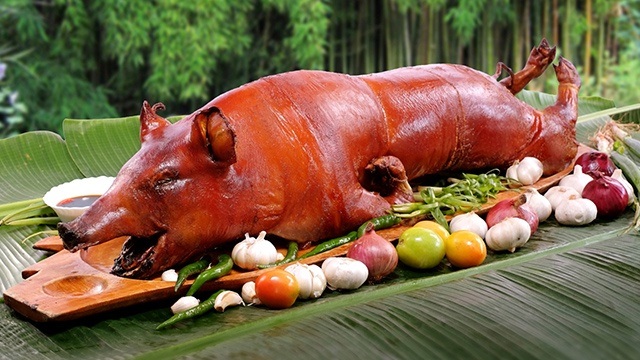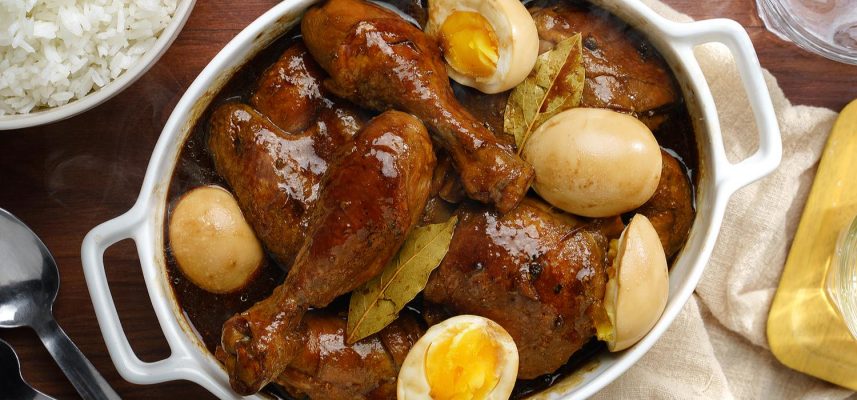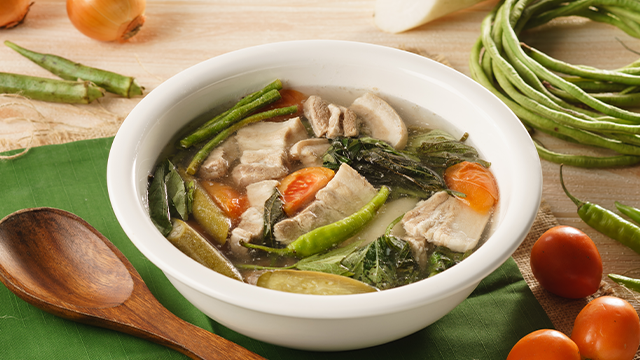On May 7, 2016, the National Commission for Culture and the Arts posed the following question on its Facebook page:
“Katuwaan lang mga kababayan, kung magkakaroon ng pambansang ulam, ano ang pipiliin mo, adobo o sinigang?” (Just for fun, if we were to have a national dish, which would you choose? Adobo or Sinigang?)
The accompanying Twitter poll revealed that users were split, with 42% supporting adobo and 40% supporting sinigang. The remaining respondents either supported both (11%) or another food entirely (7%).
To date, no official legislation or document assigns a single dish as a “national dish” representing Filipino cuisine. Even the best chefs and restaurateurs in the Philippines are hesitant to name one as the “national dish” of Filipino cuisine.
There’s not a single national dish for a country comprising over 7,000 islands since each region has its own specialty. There are, however, top contenders for the position of the national dish: lechon, adobo, and sinigang.
Lechon
One of the most well-liked meals in Filipino cuisine is lechon. It is frequently served at events like birthdays, fiestas, anniversaries, holidays, and other festivals. It brightens every meal of every home.
The modern lechon was made in Cebu in the 1920s in Talisay, Cebu. You might claim that this is why Cebu is always mentioned when the word “lechon” is mentioned because it is where the best lechon is made. Cebu Lechon was dubbed “the best pig ever” by the late Anthony Bourdain.
If you’re from the capital, the best place to go to satiate your lechon cravings is at the Lechon Capital, La Loma in Quezon City. The area is home to several lechon stalls. Even the entire month of May is dedicated to the annual Lechon festival.

Did you know that, even though lechons look identical, there are differences between lechon from the Visayas and Luzon?
Lechon from the Visayas is tastier and slightly more challenging to prepare than other types. In order to make the lechon more savory and aromatic, the pig’s insides are removed and stuffed with a variety of spices, including lemongrass, onion, leeks, laurel, ground black peppercorn, garlic, and salt.
However, Luzon lechon is a far more straightforward variation. They make do with the sauce and don’t rely heavily on the stuffing inside to enhance the flavor. In the Visayas, people prefer dipping their lechon in vinegar instead of the liver sauce known as Mang Tomas that most people in Luzon prefer.
Adobo
While certain aspects of its history are difficult to pinpoint, others are well documented. The word “adobo” is derived from the Spanish word “adobar,” which means “marinade,” “sauce,” or “seasoning.”
Before the arrival of Chinese traders in the late Tang Dynasty, around the 9th century A.D., who brought with them several essential items like pancit noodles and soy sauce, Filipinos were already marinating their proteins in a mixture of vinegar and salt. Soy sauce eventually took the place of salt in Filipino households, and the custom is still practiced today.
Later, when the Spanish came and colonized the archipelago, they saw how Filipinos marinated their chicken, pig, and fish in vinegar. Spaniards coined the term “adobo” after noticing parallels to Spanish adobar, which uses paprika, oregano, salt, garlic, and vinegar to preserve and enhance its flavor.

Most adobo recipes still call for soy sauce and vinegar as essential ingredients. Traditionally cooked in clay pots, Adobo is now frequently made in metal pots, even woks. Aside from the basic components, there is great disagreement regarding how to prepare adobo properly. Unsurprisingly, there are several regional and homegrown varieties.
Depending on the location, adobo’s most basic seasonings include garlic, bay leaf, whole or crushed black pepper, and vinegar. Other frequent ingredients are onions, ginger, sugar, hard-boiled eggs, morning glories, and other vegetables, like potatoes.
Sinigang
It’s common to see sinigang on a Filipino’s table. It is a dish prepared so frequently that it doesn’t require a particular occasion; if it does, replace the regular pork or fish with beef. Some people use beef ribs or bulalo to kick things up a notch.
Chef Robert Bolanos, Director of Culinary Operations at the Fairmont Makati, says that sinigang is a strong rival for the title of the national dish because it’s so versatile.
With thousands of large and tiny islands making up the archipelago, the variety of regional cuisine is remarkable, making it virtually difficult to confine sinigang to a single dish. Since this homemade cuisine depends on seasonal supplies, from the souring agent and vegetables to the protein, most cooks don’t even have a reliable recipe. In the Visayas, batwan is frequently used to sour down sinigang. However, in Luzon, Sampaloc and kamias are more regularly used. Bayabas, guava, and even santol are some more stomach-churning components (although some also imply a certain fruity sweetness). Even strawberry is used in one well-known Baguio City restaurant to spice things up.

A sensitive topic that frequently provokes contentious conversations in online forums is the ongoing argument over whether the national food of the Philippines is adobo or sinigang. According to food critic Doreen Gamboa Fernandez, the sour soup appeared to be the dish that best embodies Filipino flavor.
Even if the dishes listed above are not everything that may be considered to be Filipino cuisine, they all may share one thing in common: they reflect not only our land and geography but also the customs and lifestyles of the Filipino people.
Source:
- https://www.cnnphilippines.com/life/leisure/food/2017/06/14/national-dish.html
- https://gulfnews.com/travel/destinations/so-whats-the-national-dish-of-the-philippines-1.1533525
- https://www.philstar.com/lifestyle/food-and-leisure/2018/07/12/1832621/why-dont-we-have-official-national-dishes
- https://www.spot.ph/eatdrink/the-latest-eat-drink/75589/sinigang-philippines-unofficial-national-dish-a1626-20181104-lfrm2
- https://guidetothephilippines.ph/articles/history-culture/philippines-food-guide
- https://primer.com.ph/tips-guides/2019/05/26/lechon-the-all-time-favorite-fiesta-food-in-the-philippines/

